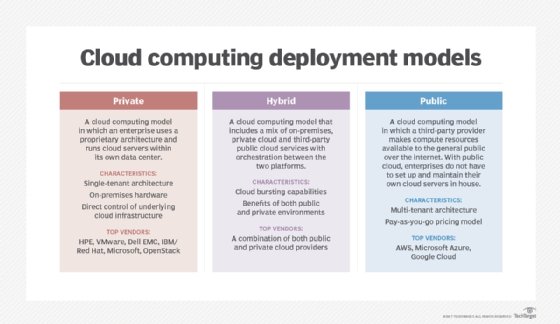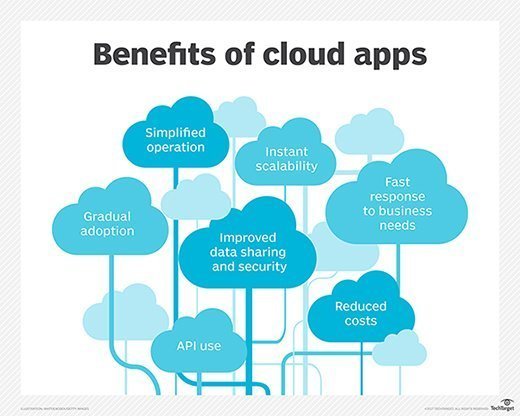10 FAQs about cloud computing
Learn the basics of cloud computing with answers to these frequently asked questions. Review the different types of clouds, and see how your company can get started with them.
Cloud computing continues to gain acceptance, but plenty of misconceptions remain. Check out these frequently asked questions about cloud computing to get a better sense of what it is all about.
1. What is cloud computing?
Cloud computing is a delivery model that provides highly scalable, on-demand access to computer resources, including CPUs, storage, networking and other hosted software services.
2. What are the types of cloud?
Clouds can be public or private, though public clouds are more commonly associated with cloud computing. Public cloud platforms, such as AWS and Microsoft Azure, pool resources in data centers often distributed around the globe, and users access them via the internet. Resources are provided to customers through metered services, and the cloud vendor is responsible for varying degrees of back-end maintenance.
Private clouds are walled-off environments hosted in a corporate data center or a colocation facility. They lack the massive scale of public clouds. But they do have some elasticity, and a company's developers and administrators can still use self-service portals to access resources. In theory, private clouds provide greater control and security, though it's up to a company's IT team to ensure that happens.

Public clouds and private clouds can be linked to create a hybrid cloud, or two or more public clouds can be connected to create a multi-cloud architecture.
Broadly speaking, there are also three tiers of cloud computing: infrastructure as a service (IaaS), platform as a service (PaaS) and software as a service (SaaS). IaaS pertains to foundational building blocks, such as compute, network and storage. It provides the most flexibility for application development, but it also requires the most overhead. PaaS abstracts those lower-level elements and provides sandbox environments for app developers. The least hands-on cloud model, SaaS, consists of licensed software delivered as web apps.
3. What are the benefits of cloud computing?
Cloud computing lowers IT operational costs because the cloud provider manages the underlying infrastructure, including hardware and software. Those managed components are typically more reliable and secure than the standard corporate data center. These advantages free IT teams to focus on work that more directly benefits the business.
The cloud is also global, convenient, immensely scalable and easily accessible, all of which accelerate the time to create and deploy software applications. It opens organizations to a host of newer services that enable the most popular trends in application architectures and uses, including microservices, containers, serverless computing, machine learning, large-scale data analytics, IoT and more.
4. What are the disadvantages or risks of cloud computing?
While IT teams lower their Capex with cloud computing because they're not buying gear, they also add significant Opex to their budgets -- often enough to offset most or all their operational savings. Complex pricing and security models can also lead to major problems if IT teams are unable to adapt.
IT teams often must learn new skills or hire employees to navigate the cloud, and there are limits in the flexibility and control over certain cloud resources.
5. Is the cloud secure?
The clouds themselves are generally more secure than most private data centers since companies such as Amazon and Google can hire talented engineers and automate many of their practices. Cloud infrastructure providers also offer tools and architectural options to isolate workloads, encrypt data and detect potential threats.

However, public clouds operate on a shared responsibility model, where the user secures the data and applications hosted on the cloud. This division of security responsibilities varies based on the tier of cloud computing.
The process to secure a cloud environment is different from more traditional data center practices, so cloud adoption requires a learning curve for IT teams. Unauthorized access to resources is the most common cloud security threat; many high-profile exposures of sensitive data resulted from misconfigurations.
Organizations also must be mindful of data residency requirements and other governance restrictions since they don't have precise control over the location of the servers that host their data in the cloud.
6. How do I develop a cloud strategy?
In the early days of cloud, most enterprise usage was ad hoc, driven by developers and lines of business that wanted to go around traditional IT procurement processes. Today, organizations must formulate a holistic strategy to successfully move to the cloud. Assemble key stakeholders and employees with cloud experience -- a setup also known as a cloud center for excellence -- to map out a strategy based on business objectives.
Also, a cloud strategy should include a decision framework to identify workload characteristics and how those characteristics port to cloud platforms. IT leaders and cloud architects must evaluate risks and benefits and determine how they will manage and secure cloud-based workloads, as well as whether or how those workloads interact with remaining on-premises assets.
7. How do I prepare my business for the cloud?
It can take more than a year to execute a cloud migration strategy, and even then, it's an ongoing process. Communication is critical to success. Keep stakeholders regularly informed, and make sure IT is part of the broader decision-making process for the business. Identify leaders who will evangelize the use of the cloud, and ensure employees are properly trained for the transition.
8. Which workloads can I move to the cloud?
Virtually any workload can move to the cloud, but not all of them should. Large, monolithic applications that run constantly, with relatively consistent and predictable loads, are often more cost-effective on premises. Also, highly regulated enterprises tend to keep applications and sensitive data in their private data centers due to governance and data security concerns.
An organization can move an application as-is to the cloud, but that's typically not the best option. Use a cloud migration to reevaluate your IT architecture and identify greater efficiencies. An application can be broken into microservices to take advantage of the service-based approach of IaaS. Alternatively, a move to PaaS or SaaS can offload undifferentiated heavy lifting.
9. How much does the cloud cost?
Public clouds charge on a per-use basis, so costs will vary wildly based on multiple variables, including the size of your environment, the provider, the region you operate in, the amount of data movement and the number of higher-level services consumed.
The major public cloud providers also have pricing schemes that can lower costs in exchange for certain long-term commitments.
There's considerable debate about whether the cloud is ultimately cheaper or more expensive than traditional on-premises computing -- but that misses the point. The cloud can help modernize an enterprise and its IT department and transition IT from its typical role as gatekeeper into a key participant in the decision-making process for the business side of an enterprise.
10. What training does my IT staff need to manage the cloud?
This depends on the layer of the cloud stack being used. For IaaS, administrators must manage all aspects of the virtualized environment that's delivered as a service. The higher up the cloud stack you go, the less management involved. For SaaS, oversight might be limited to data and identity and access management.
Major cloud providers and third parties offer training and certifications to familiarize IT staff with these processes. Enterprises that plan to transition to the cloud should factor training into every aspect of the process so they're ready to take the reins as soon as the cloud environment goes live.







